
I’m not very good on either the historical or human relation ends of thing, so I’ll leave it to my colleagues to memorialize this Very Special Anniversary to the degree it deserves. Still, I’d say it’s fairly impressive for a loosely confederated batch of web writers to stay the course for an entire decade. I’m honored to say that I’ve been here since the beginning, and contributed to all but one (dammit!) of the roundtables.
We were, in admittedly a very humble field, pioneers. In the years since the B-Masters came together there have been a plethora of enthusiasts toiling the ‘b’ and bad movie fields, and many of them are damn good. However, I like to think that back in the ancient, pre-Google (or any search engine) days of 1999, when Jabootu was Ken’s World of Awful Movies and couldn’t even boast a dedicated URL, well, the B-Masters brought together the best then available. And despite all the similar sites to arise over the years, I think we yet today hold our own with anybody.
Here’s to my comrades who have also been here from the beginning, the good Dr. Freex, group workhorse Nathan, and still the person whose prose and analysis I most envy and enjoy, Liz Kingsley. Four out of the seven original participants have lasted all ten years and counting, so not too shabby. Perhaps we’ll still be doing it in another ten years, too. At that point, the biggest problem would probably be finding a film that not one of us had yet reviewed.
Sadly, we’ve fallen out of touch with Rob and Al of Oh, the Humanity (whose site recently purged itself from the Internets, a very sad state of affairs), and the good and wise Apostic, whose articles can still be found under the B-Notes rubric over at the old Jabootu.com site. I don’t know where you are, boys, but God keep you. Feel free to drop a line should the mood ever strike.
I’m downright ecstatic, meanwhile, to note the return of the Cabal’s other founding father, Andrew Borntreger of Badmovies.org. Through the years, his has probably been the most influential of any of our sites. Certainly I can’t think of a template so regularly and slavishly aped. Andrew and I go back to the early days, back when you knew you’d arrived on the Web when you got a Yahoo listing. Yes, it was indeed a looong time ago.
As Mr. Borntreger is apt to remind me, he sent me an e-mail or two back in the dark ages which I failed to respond to. He was miffed, but has gotten to know me and now understands that my anti-social, Morlock-like tendencies accounted for this rather than some intentional slight. Andrew has run his site week in and week out with a constancy only matched by Nathan’s, and only occasionally interrupted even by his tours with the U.S. Marine Corps in Iraq. Thankfully he has since returned stateside to the bosom of his family, and it’s especially good to have him back with us today.
Here’s to all the other fine folks who have joined us over the years, including those who have also since gone their way. I miss you all, guys, and I’m sure I speak for all of us who remain when I say the door is always open. The only reason I don’t mention names is because I’d be sure to forget somebody, and I choose to forgo that particular faux pas. Still, there isn’t a man jack among them with who I haven’t been proud to face the worst the cinema world could throw at us. Good on you, everybody.
Favorite Roundtables? Well, obviously the first ones were probably consistently the best, back when we were young and full of piss and vinegar and all those ripe, unexamined movies hung heavily like juicy, ripe fruit from the lowest branches. There was the first roundtable, which we emulate today, wherein we all ganged up on one gloriously goofy film. The next two roundtables, where we first reviewed apocalyptic movies, neatly followed by post-apocalyptic ones. The Giant Monsters roundtable. And, of course, the Jaws Knock-Off roundtable, to which I contributed the conjoined pieces that I like to think represent my best work.
Ten years in the book. Here’s to 2019.

Regional filmmakers had been around since the invention of the cinema itself. I mean filmmakers, generally hyphenates—not just directors but director/producer/whatevers—who didn’t make films for national mainstream consumption but rather for distribution through either regional drive-in or hard roof theater chains, or specialized venues (generally for ‘adult’ or ethnic audiences) like the pussycat and grindhouse circuits.
Indeed, until filmmaking was established as an industry in Hollywood, pretty much all filmmakers were regional by definition. Regional filmmaking in a proper sense, however, began when Hollywood became the national source of film. Hollywood created films for the country at large; regional filmmakers, generally in the South, produced their wares for a cliental closer to hand.
As such, these independents were largely reactive to what happened in Hollywood. One obvious example would be the Paramount Antitrust Case in 1948 that forced the major studios to divest themselves of their own theater chains. In other words, you could make movies, or own the theaters that showed them, but you could no longer do both. This was the beginning of the end of the Studio System, and as usual in times of tumult, there was money to be made if you could figure out all the angles.
If Hollywood chased the big dollars, regional filmmakers trolled after the comparative small change that fell through the cracks. For some, such as Herschell Gordon Lewis, the movies were simply a way to turn a buck, nothing more and nothing less. Others were conversely attracted by the sheer glamour of filmmaking, even in such reduced circumstances. Most regional filmmakers, of course, lay somewhere between the two extremes.
Regional filmmaking continued probably through the early ‘90s. At this point, however, their content was distributed via home video. Such being the case, they were no longer really ‘filmmakers’ in a traditional sense. By this point, Hollywood’s increasingly gigantic budgets and rapacious appetite for zillions of screens on which to release their latest would-be blockbusters, had basically driven the regional guys off theater screens entirely. Ironically, the explosion of multiplexes actually reduced the ranks of independent filmmakers, since again Hollywood wanted each and every single screen for themselves.
As well, Hollywood no longer left the grubbier film genres (save for hardcore porn) unexploited. Many saw the end of the tunnel coming when Paramount stooped to release the horrifically violent Friday the 13th and gleaned millions in profit from doing so. With the studios at last prepared to give audiences pretty much whatever they wanted, and being able to produce such fare with a level of craft far beyond that of even the most ambitious regional guy, well…
An era had passed.
The ‘60s to the early ‘80s, however, were a kind of golden age for regional filmmaking. There was still room for the little guys, and still deals to be made with local independent theater chains in the years before those also fell prey to industry consolidation. Meanwhile, drive-in theaters all but disappeared, killed by a combination of ever-rising property taxes and a trend towards smaller cars. Nobody wanted to sit for four hours crammed in a Gremlin.
Ah, but the halcyon days before the end! In this golden era localized filmmakers established fiefdoms throughout the nation. Larry Buchanan worked down in Texas. H.G. Lewis and Doris Wishman, among many others, worked out of Florida. Earl Owensby, who somehow managed to actually star in his films despite a notable lack of talent, built his own studio in North Carolina. William Girdler, before he moved on to bigger things and then tragically died at a young age, made movies in his native Kentucky. Bill Rebane made monster flicks in Wisconsin; Don Dohler did so in Baltimore. And that’s just scratching the surface.
As noted, many such filmmakers worked out of Florida. Florida boasted many of the same advantages as Hollywood itself, and had been a rival for the seat of the industry until California took the crown. Even so, it boasts long days, lots of sun (more of a factor for skid row filmmakers, who couldn’t afford the best film stock, nor wanted to pay to rent and haul around tons of klieg lights if they didn’t have to), generally pleasant weather and a rich variety of landscapes. The warm weather and copious beaches also drew beach bunnies and nudists.
If the latter often ended up working for Doris Wishman and her fellows in the nudie trade, scads of their less adventurous peers appeared in the films of today’s Artiste of the Moment: Mr. William Grefé. Mr. Grefé worked in a variety of exploitation genres, but if one consistent element grants him auteur status, it is the preponderance in his films of awful but enthusiastic dance sequences that afforded abundant opportunities for shapely and barely clad butts and boobs to gyrate before his attentive camera.
Unsurprisingly, the best remembered (in a relative sense, of course) of Mr. Grefé’s works were his horror pictures. One of these provides our subject today.
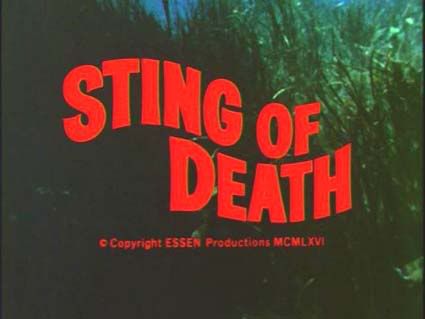
This is just the kind of movie that justifies itself in its first few seconds. We open on a small expanse of workbench sporting a couple of tools. Generic instrumental music plays on an offscreen radio, as a gaudy rubber ‘monster’ hand reaches into frame to grab a screwdriver. If you’re not already settling down in your chair with a contented sigh, then man, you’re visiting the wrong website.
Having obtained the requisite tool, we are now treated to a POV shot from whatever sort of beastie this will prove to be. Unseen, it approaches a rather ramshackle collection of electronic equipment.
At this point we cunningly cut to a rather more presentable hand reaching for the wee transistor radio that’s been providing the aforementioned music. The camera follows the hand as it retracts and we see it belongs to a bikini babe lounging on a towel. Said towel is rather thin and draped over a rough wooden plank dock, an arrangement that doesn’t look entirely comfortable. Moreover, the towel is positioned under the shade of a tree. Apparently the bikini babe is working on her pale.
Back to The Old Zombie Workshop, or whatever this is. The Monster Hand shoves the blade of the screwdriver into some exposed electronic guts—actually, it lays the flat end of the blade gently atop some insulated wires—and…wow. They couldn’t even rig up some sparks. Instead, we get a red animated explosion effect, much like those in the fight scene interstitial cards from the old Batman TV show. Sadly, though, this does not say “Pow!” or “Zowie!”, or, more appropriately, “WTF?!”
Back to Bikini Babe. In a key William Grefé auteurial moment, the camera frames (albeit haphazardly off-center) over her butt. Meanwhile, a radio announcer blathers on about some missing fishermen. Not to rock your world, but I imagine this will at least tangendentally tie in with the movie’s events.
Having accomplished…something…with the screwdriver, the still Mostly Unseen Monster is now seen shuffling around outside. He is, we can safely presume, stalking towards our unsuspecting un-tanner. Apparently Mr. Grefé thought it a tad early to expose more of the monster suit to what might well prove to be the uncharitable gaze of the audience. This is especially true given that said costume clearly consists of a black wetsuit and flippers inartfully spattered with schmootz, and garlanded with a hanging batch of blue plastic streamers.
Bikini Babe rouses and—oh no!—quite nearly moves into direct sunlight. Don’t worry, though, for in the end she remains safe from the scourge of melanoma. To be sure, though, she pauses to apply sunscreen. Considering that the overhanging tree has a SPF rating of 6,000, this is arguably superfluous. Still, better safe than sorry.
Ominous music plays, and somewhere down the dock where Bikini Blond doesn’t observe it occurring (despite the fact that the dock seem to be fifteen or twenty feet long, tops) the Monster Legs enter the water. Here we can quite clearly see that it IS just a wetsuit. As we’ll later learn, there’s actually a reason for this, but given our current state of unenlightenment the sight is still rather funny.
We cut from Bikini Blond to the Monster. It’s wading through some water in a shot that in no way suggests that the Monster is actually anywhere in the same neighborhood as its presumed victim-to-be. Meanwhile, its head continues to remain unseen. I’ll assume this was intentional, although considering the way Grefé had trouble framing a prone woman’s butt two feet from the camera, it’s possible I’m being over-generous.
She continues to slather on the sunscreen, less an errant ray peek through some leaves and strike her. Seriously, vampires are less concerned about the sun than this. Cut to the Monster now swimming through some suspiciously clear waters, almost like it was in a swimming pool. The tempo of the music quickens and the Monster Hand, now cleaned by the water and clearly just a wetsuit glove, emerges from the drink to fasten onto her leg.
She (kind of) struggles as the hand pulls her underwater, and her hair instantly straightens in a way that it clearly wouldn’t, and she struggles to escape and just generally wastes a bit of time. Hey, you’ve got to fill those 80 minutes somehow, and even William Grefé can only insert so many bum-shaking dance interludes. She even nearly escapes, but it’s all for naught, and so victim #1 is in the books. You’d think a death only two and a half minutes in would be at least a minimally good sign, but, yeah, it’s not.
Cut to some Generic POV Underwater Scuba Footage accompanied by some Generic Serene Underwater Library Music. See, the contrast between the seeming peace and hushed tranquility of the water, which is then dramatically belied by…well, OK, ‘dramatically’ might be overstating things a little.
One can only assume that this is library music—preexisting music untainted by copyright, that is, and available for free use by all—given that it never turns ominous when the title appears, or even when we begin to follow along under Bikini Babe’s corpse, its blond tresses streaming behind her as she floats through the water. (Was Grefé even halfassedly trying to steal from Charles Laughton’s Night of the Hunter here? Because if so…wow.)
The camera follows her for quite a while, presumably to impress us with the actresses’ ability (and more remarkably, willingness) to hold her breath. If so, our awareness of her efforts is somewhat short-circuited by the appearance of a credit reading “special singing guest star NEIL SEDAKA.” Yes, really. One can only wonder how the hell Grefé brought this about, and how much of the film’s not apparently great budget went in that direction.
Eventually the framing goes wider, and I see that the woman isn’t so much floating through the water as being dragged by The Monster. This again suggests either that Grefé didn’t know how to frame his shots, or that even a bare three minutes into the proceedings my mind is already having difficultly focusing on what’s occurring on the screen. It’s more the latter than the former, actually, which handily suggests exactly how exciting this all has proven so far.
Eventually the Monster drags her body further under water. I suppose if you are especially diligent, or just lazily watching the film out of the corner of one eye, you just might maybe notice the fact that they are in fact clearly swimming past the side panels of a pool here. Hello, Zombie Lake!
Eventually we shift our focus from the monster-pulling-the-body stuff to the bottom of a small motor boat cutting along the surface of the water above. Now, Grefé was never by any means a great filmmaker. He certainly wasn’t this early in his career, as Sting of Death marked only his third directorial effort.
Even so, it should be noted that he at least procured an actress who, all joking aside, ably mimes a corpse at length whilst holding her breath underwater—a harder task than it sounds—and an underwater cameraman who proves quite good at his job. Aside from some nice shots, the latter manages to keep the monster’s head off camera even as it repeatedly swims past his lens. I wonder how much footage that accidentally revealed this apparent secret hit the editing floor.
So the monster and the body disappear into the deep, while topside the boat arrives at the dock and disgorges a batch of characters. One is our putative lead, Dr. John Hoyt, a hunky young chap wearing blue slacks and a French sailor’s pink and white striped shirt. We also now meet his employer, Dr. Richardson, whose khaki attire and balding pate function as able metaphors for how dynamic and charismatic he will prove to be.
As for the rest, well, it’s hard not to laugh when a literal boatload of potential cheesecake shots and victims arrive like an assortment pack ordered from a mailing catalog. [“Includes: One Final Girl™, guaranteed to last to the end of the picture!”] The ladies prove to be Richardson’s daughter Karen and four of her college friends.
Since this is the ‘60s, and the South, all boast chic country club dresses, elaborately coiffed hair, and even white gloves. (!!) For easy identification, these include a) one honey blond*, b) one platinum blond [short hair], c) one light-haired redhead and d) one darker-haired redhead. Actual names optional and generally unnecessary.
[*The honey blond is played by Deanna Lund, the only actor associated with this film to have anything like a successful Hollywood career. Ms. Lund remains best known for playing the character Valerie Scott on Irwin Allen’s TV show Land of the Giants. She continued to work, mostly doing TV guest work, until she retired in the early ‘90s. Sting of Death was her earliest credit. Younger schlock fans might remember her, though, for playing the heroine’s mother in the atrocious 1989 travesty Elves. Hard to believe she retired from show biz, huh?]Having arrived at the fairly grand Casa de Richardson, complete with an Olympic-sized outdoor pool, we can now begin the Grand Expo of Exposition. Various characters oblige by saying things like, “The island offers the seclusion I find necessary for my work.” Remarks like this continue to be issued during the scene, and will be highlighted for your edification.
Arriving at the swank and complete poolside kitchen and dining area, Richardson has Karen fetch the Orange Ade. “Karen tells me you work in marine biology,” Louise the Dark Redhead observes. “John and I are working with sea life and evolution,” Richardson replies. “The deep waters of the Gulf of Mexico are right over there, and about a half mile in that direction is the edge of the Florida Everglades.”
Meanwhile, John walks by with their suitcases, and pauses to note “I don’t know why you brought all this when a few bikinis would have been enough!” Ha, he’s creepy. Actually, four young women (and the sort with elaborate hairdos who wear white gloves when traveling) traveling with one smallish suitcase apiece and a single make-up case between them? It’s more like they packed while fleeing a flash fire.
We finally get a good gander at the other side of Richardon’s face, and see that he sports what looks like a large black mole on his sizable forehead. However, it turns out to be a blood blister. “Someone stole some of the equipment out of the lab,” Richardson tells Karen. “And while I was looking for it, an amplifier fell out of one of the cabinets and hit me on the forehead.”
Karen opines that John is ‘great.’ Really? Well, it takes all kinds, I guess. Presumably living on an island with Richardson and his other, even creepier assistant as the only other males helps John in the comparison department. (And, oh yes, I forgot that attractive guys can say stuff like that and get giggles in responses, rather than blasts of mace.) Also, I can only assume that Karen’s been matriculating at an all-girls college, since otherwise you’d think she wouldn’t be quite so easy to impress.
Richardson seems equally surprised by her reaction, though. (Or perhaps he’s just realizing that having Dr. Hunk around his sheltered daughter all the time might not be such a great idea.) “That’s right,” Richardson opines. “You haven’t seen him before, have you? Well, keep your mitts to yourself, missy; that slab of beefcake is all for Papa!” Actually, I couldn’t entirely make out that last sentence, so it may not be 100% accurate. In any case, as Karen clunkily confirms, “John came to work for you after I went to school.” Richardson agrees, noting “The University assigned him to me for the next phase of my research.”
They also remember Ruth at this point, who proves to be the ex-blond that was down by the dock. Her identity being now pointlessly established, they move on.
John wanders back and mentions that he’s invited a bunch of fellow youths over for a party. “A party!” Karen gasps. “With us, looking like this?!” one of the girls agrees. “My hair’s a mess!” another adds, looking like it has indeed been upwards of several minutes since she left a beauty parlor. Still, you can see the reason for their consternation. What if the guests arrive before they switch from their formal traveling white gloves to their informal pool party white gloves? Hearing that they have but a mere fifteen minutes to prepare, the ladies all run off for some speed primping.
Before this, though, we meet our final major character, Egon. (!) This fellow ninjas suddenly into view and scares all the refined young ladies, since he proves a disfigured assistant of the Igor school. Although in this case, ‘disfigured’ means that one side of his face is tanner and rougher than the other and bears a droopy eyelid. All in all, if Peter Falk gives you the heebie-jeebies, Egon probably will too. Moreover, in an attempt to further the horror of his visage, Egon also slumps his shoulders in a mopey fashion, in direct contrast to the erect posture of Hunky John.
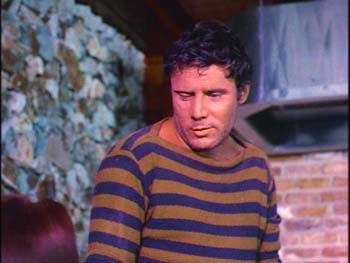
Gaze, if you can, upon the inexpressiable horror that is…Egon!
Trapped in a world he never made, Egon proves bitter about the way people treat him. This is highlighted when Louise rather assholishly mocks him.* Per tradition, however, he has a single soft spot in his heart for Karen. She has always been, as he inevitably later explains, “the only one who was ever nice to me.” Man, that’s some original scripting there. Karen, indeed, tries to smooth his way with the ladies. “He’s one of the best swimmers I’ve ever seen,” she extols.
[*Thus diminishing her chances of survival in this thing to about, oh, zero.]The girls leave, and Richardson explains the facts of life to young John. “What’s she so upset about?” John wonders. (Awesomely, I’m not even sure which ‘she’ he’s talking about.) “She’s just taking the prerogative of a woman,” Richardson says. “Who can understand women?” he continues, chuckling. Man, there are times I’d pay five bucks just to watch Liz Kingsley watching a movie.
John upbraids Egon for his surliness, whereupon they are interrupted by an arriving boat. Going to the dock, they find it’s a police launch ferrying the local sheriff. “Business or pleasure, Bob?” Richardson asks. Since the Sheriff is clearly standing next to a dead body covered with a sheet, I’m not going to think very hard about what that question might mean.
Sheriff Bob has indeed brought the body of one of the dead fishermen, as explicated earlier via the Expository Radio Broadcast, to get Richardson’s opinion of the cause of death. Whipping off the sheet covering it, we see that the victim apparently feel victim to a really, really bad make-up job. If I were guessing, I’d say he had fallen into a doughnut glazing machine, but Richardson is stumped.
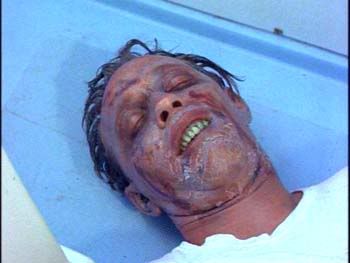
“All we can say for sure is that the victim appears to be British.”
Richardson notes the welts (well, not welts, really…), and John adds his two cents. “It looks like a Portuguese Man-o-War,” he suggests, “but it’s impossible.” Uh, if it’s impossible, then it probably doesn’t really look like a Portuguese Man-o-War, does it? Egon smugly suggests that John was right in the first place. It turns out that he’s been long arguing with the others that a Portuguese Man-o-War could be bred to a huge size (comparatively), only to have his theories summarily dismissed.
No doubt adding to Egon’s distemper, the others start talking about him as if he weren’t there. Richardson waves away Egon’s remark with a flick of his wrist. “Egon fancies himself quite a biologist,” John explains. (What a dick.) “For a long time now he’s been trying to convince us that it’s possible to cultivate a giant Man o’ War.” He and Richardson continue to blow off the suggestion. And why not, since they are currently, you know, staring at a body that appears to have been killed by an outlandishly large Man o’ War. It’s really kind of hard not to start taking Egon’s side in all this.
By the way, you might be putting together all the pieces here. Let’s see. Egon is a disfigured, disgruntled scientist’s assistant, angry at the world, a terrific swimmer who considers himself a great biologist—all while reaping the scorn of less imaginative scientists—who has long argued that one could breed a giant Man o’ War. You might also be saying to yourself, though, ‘well, wait, they can’t be making things this obvious only eleven minutes into the movie.’ My friends, welcome to the film oeuvre of William Grefé. Although I’ll admit he has a doozy of a twist for us later in the proceedings.
John and Richardson then disseminate several incorrect bits of data on these creatures, despite the fact that they “work with them every day” in their lab. Richardson claims that they never reach more than eight inches across, while John adds that they have “a small tentacle.” Presumably the eight inches refers to the sail, or balloon body of the Man o’ War, which in fact can reach nearly twelve inches across. More to the point, though, the tentacles of a Man o’ War can reach up to 165 feet in length, not exactly what I’d call ‘small.’
John next dismisses Egon’s theory that under the right condition “you can breed them like cattle.” His evidence? He and Richardson have never been able to raise any in captivity. Well, that proves it. “You know Egon!” John finishes. And again, he says all this with Egon standing right there. Hey, are we supposed to want Egon to kill all these people? Because if so, mission accomplished.
Anyway, having gotten their opinion, Sheriff Bob decides to now take the body to the medical examiner. Yeah, that’s probably a good idea. John has more to contribute, however. “Why not have the pathologist run a chemical breakdown on the tissue around the wound?” he suggests. Gee, Einstein, ya think? “That’s a good idea,” Sheriff Bob admits. Tell me, what exactly would the ME have been doing otherwise? Conducting a phrenological survey of the victim’s head bumps?
Cut to the girls in…what the hell is that?! Is that Karen’s bathroom?! Good grief, it’s huge, with three or four sinks, a triple length mirror and lighted ceiling panels. Anyway, the girls are messing with their hair, and still complaining about the lack of time to prepare for John’s party.
Karen runs down stairs to the exterior patio kitchen where she finds John. He chats her up for a bit, in a highly smooth ‘you’re sure pretty…and that’s all you need to be!’ fashion. When Karen learns the Sheriff was there and asks why, he replies, “Oh, nothing important.” Then she asks how her dad’s work is going, and he responds with “I won’t bore you with the details.” Who knows, maybe there was math involved! Again, I imagine Liz Kingsley was having a good time during this section. And mentally urging Egon to get on with the killing already, no doubt.
In any case, Karen doesn’t protest this treatment, although she does make time to AGAIN whine to John about the lack of prep time for the party. Gloria Steinem, she ain’t. And when John, er, suavely tells her “you’re perfect as you are,” she responds, “Well, that’s very flattering!” Boy, nothing gets past you, Karen. Then Dad shows up. Karen exhorts him to hang around for the party, but he wisely elects to go on a working field trip instead. I’d like to join him, but I’m stuck watching the rest of this movie.
Still, you have to enjoy when Richardson begs off via an incredibly awkward line-reading: “Karen, these new dances [weird pause]…are not for me. Your mother and I used to shine doing the Big Apple. [chuckles] But the Twist? The Ska? Uh-uh, not for us senior citizens!” I think I’d pay another five dollars just to hear Christopher Walken say those lines.
So Dad departs, and John wanders off, too. Then Egon ninjas directly behind Karen, startling her. He sorta kinda expresses his feelings for her, which basically amount to, “Yeah, I’d kill everyone else, but not you.” Reading between the lines, that is. Again, Egon’s guilt either as monster-maker or direct perpetrator is so obvious so early on that I’m sure many will write him off as a red herring. He also almost quite nearly caresses her, in an “I’m not touching you!” manner that suggests he’s a summa cum laude graduate of the Torgo Academy of Ineffectual Air Groping.
Cut to the girls hanging out on the pool. By the way, if you’re taking umbrage at me calling them girls, well, I defy you to watch the movie and call them women. They chat pointlessly for a bit, apparently just to eat up some of the film’s 80 minutes. About all that is accomplished is to establish that the equally posh house across the canal belongs to Karen’s uncle, and that it is currently unoccupied whilst he’s away. So I’d guess Egan has his Mad Jellyfish Lab over there. (Oops, sorry.) *
[*Nope. Maybe they just couldn’t keep it out of shot, and wanted to explain it, since Richardson’s house is supposedly in this remote area.]Then John shows up, running through the scene carrying an oddly small block of ice. Yes, that should cool a single six-pack of beer quite nicely. He reports that the soon to arrive partiers are “young people from the University.” (That’s a natural turn of phrase for somebody under the age of 60.) “They really like to cut loose,” he assures them. “Crazy!” one of the girls responds. My sphincter is tightening already in apprehension of the dire terpsichorean horrors to come.
Seconds later, in fact, their boat arrives and disgorges about fifteen entirely too merry partiers. They hit the dock and instantly begin perpetrating some of the most appalling White People dancing I’ve ever seen. And I’ve seen Horror of Party Beach and The Creeping Terror. It looks like a “Know Your Enemy” segment from a particularly crude Black Nationalist propaganda film.
The assembled guys and gals frug away to the strains—a term I use advisedly—of some highly generic pop tune called something like “Do What You Did When You Did What You Did Last Night.” And yes, this provides for the film’s first wave of frenetically shaking butt shots. Welcome to the cinematic oeuvre of William Grefé.

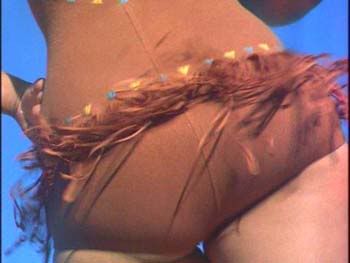
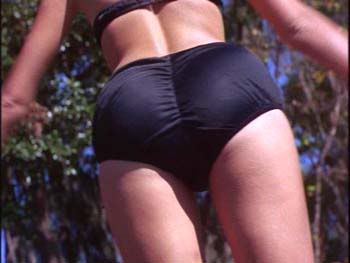
This review is brought to you in Grefé-O-Vision.
Anyway, the scene is so gosh darned ebullient that even Egon, standing off to the side, starts getting into a cheerful mood. However (surprise!), this is quickly dashed when the apparent leader of the Young People—who appears to be at least 40, which is kind of creepy—spots him. The Leader then cries out in a horrible pirate brogue (!!!) that Egon is “one of the King’s spies!”
Egon reassumes his natural surliness and runs off. At this the Young People inevitably start chasing him as a beatnik-ish bongo drum beat plays evocatively on the soundtrack. The panicked Egon trips and the kids encircle him as he snarls like a trapped animal. Grefé uses a fisheye lens as he scans the menacing faces of Egon’s tormentors here, which frankly represents his big directorial flourish.
Karen yells for them to leave Egon alone—and again, I get a feeling that on the other side of the globe Liz Kingsley is urging Egon to get with the Srendi Vashtar-ing already—but they continue to act like complete dicks until the irate assistant manages to escape. Even better, the film’s ‘hero’ John, who works with the guy everyday, just stands there and watches all this in silence, even as Karen stands right in front of him and screams for the people John himself invited here to stop. Heroes don’t come much more designated than this guy.
Anyhoo, Egon escapes and hies himself off on an air boat.* Strident music plays on the soundtrack, hoping to convince us that something exciting is happening. Karen shrillly berates the Young People—you know, the ones from the University—with John finally joining in now that all the damage is done. You’re a rock, dude. I think I’d like this movie about a thousand times better if Karen looked at him in disgust and then kneed him in the crotch.
[*By law, any film set on or near the Everglades must showcase an air boat. It’s like showing a trolley in a film set in San Francisco.]Instead, and I will admit this authentically filled me with horror, the still too jocular by half Young People make their way back to the pool area via a conga line, accompanied again by bongo music. Given the formidable lack of skill displayed in even this rudimentary rhythmic endeavor, I pondered on the strong possibility that Grefé paid his extras with free beer.
Back to Egon, who halts his craft somewhere in the swamp. He dives into the water, as the film cuts to a beer being poured into a foaming glass. My mistake; this is Grefé’s big directorial flourish. Or his big editorial flourish, anyway. Meanwhile, the cast is really unsuccessfully attempting to communicate what a frenetic Bacchanalia they are all engaged in.
Much Too Old Leader Guy whistles for attention. “Listen all you pirates!” he commands. Again with the pirates? Seriously, none of these folk looks remotely drunk enough to find the whole pirate thing amusing. Even so, Leader Guy talks about drinking grog and dancing with wenches, and OH, the fun!
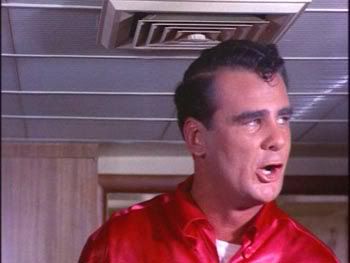
Boy, the kids just seem to get younger every day.
The Young People leave so that that John and Karen can have a sappy scene together to advance their inevitable romantic pairing.
John apologizes for “the scene with Egon,” which he did absolutely nothing to stop. Karen lets him off the hook, though. Then the two end up smooching, and to ‘romantic’ piano chords, yet! You really have to wonder what Richardson’s going to think about this guy macking on his daughter two hours after meeting her for the first time.
Cut to the Wetsuit Monster—again portrayed via a Doris Wishman-like feet (or more accurately, flipper) shot—as he approaches the backyard pool. He eases into the water seconds before The Gang makes the scene. Hilariously, none of them notice his black form lurking in the crystal clear water against the pool’s sky blue paint job. In broad daylight, yet.
Apparently afraid someone in the audience might find this peculiar—not to mention utterly retarded—they have one girl say, “I thought I saw something in the pool!” Somehow even this remark fails to get anyone to discern what is basically a tarantula on a slice of angel food cake.* This lack of discernment is supposedly ‘explained’ when someone replies, “All you need is some more beer!”
[*Thank you, Raymond Chandler.]“I’ll settle for music,” the almost observant damsel decrees. Unfortunately, the phonograph record selected instead inexplicably plays Neil Sedaka’s (!) immortal dance tune, “The Jellyfish.” This leads to a fit of ‘help, I’ve got ravenous fire ants down my shirt’ writhing that makes the group’s last bout of contortions look like something Gene Kelly choreographed. If nothing else, it answers the question of what you’d see on a TV show entitled, “So You Think You Can Dance…Because You Really, Really Can’t.”
No words I can muster could pay proper homage to the inexorable horrors we are now privy to. Hell, the pen of William Shakespeare would prove insufficient. (On the other hand, H.P. Lovecraft might get the job done.) Luckily—well, not for you reading this—I don’t have to demonstrate my manifold literary inadequacy, since some kind (?) soul on YouTube has provided the following:
I’m assuming this is Sedaka’s most embarrassing cinema moment. However, a few years later he did take a major supporting role in 1968’s Playgirl Killer. Sedaka never acted again after that, so take it for what it’s worth. Meanwhile, Playgirl Killer was written by the Kerwin Brothers. One of them, William Kerwin, also played the lead. However, a few years earlier his brother Harry worked make-up on…Sting of Death. So presumably they were the guys who got Sedaka to sing “The Jellyfish.”
In case you’re wondering, the lyrics of the song really DO go, “Wella / I saya fella / get your Cinderella / and do the jella / the jilla jalla jella / it’s really swella / to do the jella jellyfish / Hey! / Monkey! / Don’t be a donkey / it’s nothing like The Monkey! / It isn’t funky / or anything that’s junky! / it’s something swella / the jilla jalla jellyfish.”
Meanwhile, in an auteurial tour de force Grefé mixes things up with (female) crotch and boob shots as well as butt shots. In service of these, one singularly accommodating young lady helpfully leans her bikini-clad cleavage right into the camera.
At one point during this we see the Monster’s arm start emerging from the pool (not that anybody notices), as if he’s ready to leap out and attack. And really, who can blame him? However, he sinks back below when Richardson makes an appearance, presumably because of the latter’s highly unfortunate blue shorts. These aren’t short-shorts, but seriously, anyone with legs like that should be legally required to wear long pants at all times, including in the shower.
When the horrors of the song and dancing are finally behind us, Grefé wisely offers some comic relief: Louise (dark redhead) jumps into the pool—unbelievably, no one joins her—and is summarily kacked by the yet mysteriously undetected Monster. Ha, ha!, that breaks the tension, all right. I mean, when the last thing Louise says before jumping into the pool is, “I’m on vacation; let’s live!”, or when Karen shortly after laughs, “you nut, you’ll kill yourself!” (while swimming languidly in a backyard pool?????), or when Richardson adds, “let her be, Karen, I guess she’ll survive,” well, that all can’t seriously be meant to evoke dramatic irony. Can it?
By the way, if you thought it was improbable *cough*impossible*cough* that none of the nearly twenty people standing poolside saw the Monster swimming around in there, the idea that Louise never sees him while swimming around for several minutes in the exact same pool is just downright insulting. And the idea that nobody even notices her being attacked all of ten feet away…yeesh!
Anyway, Louise ends up with venom smeared all over her face. The others then finally see the Monster when he emerges from the pool and begins walking in their direction. He grabs another guy’s face as the rest scatter, and then slowly ambles off. All the while, the film kept the Monster’s head out of our field of vision. You just know this obvious build-up to a supposedly big monster reveal is writing a check the film can’t remotely hope to cash.
The gasping, writhing victims are laid down by the pool. Then Richardson appears wearing completely different clothes than he had on twenty seconds ago. He indeed had a line about changing into dry clothes; the problem is that the clothes he was wearing were already entirely dry. And why would he change out of a ‘wet’ pair swim trunks into another pair of swim trunks? Especially with legs like that?
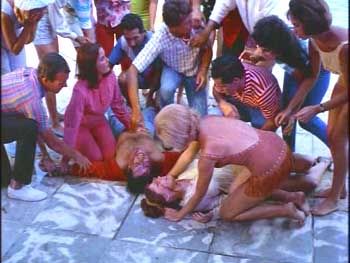
”The fools! I told them to stay out of the pool for an hour after they had eaten!”
Richardson has Karen fetch his doctor’s bag, which of course he’d have as a marine biologist. This is, after all, the guy who told the Sheriff, “I’m not a pathologist; biology is my line.” However, the make-up jobs on the victims keep getting more elaborate, so presumably they’re done for. ‘I’m sure to get sued for this,’ we can imagine Richardson saying. ‘Karen, go get my attorney’s briefcase.’
Meanwhile, John returns with dire news, reporting that the two-way radio’s been smashed. He tells Young People Leader to get his charges on their boat and take the victims back to the mainland. There he should contact the Sheriff from the hospital and send him out to the island. (Doesn’t the boat have a radio?)
Leader Guy asks if Richardson wants them to take along Karen and the rest of her friends. Richardson decides no. Nobody bothers to ask the girls their opinion on the matter, but then, why should they when there are men around to decide? Anyway, they’ll be safe here, Richardson avers. “We have guns.”
Sadly, the Young People’s attempt to flee is doomed by the fact that the Monster is under their boat with a little hatchet. This might seem like an insufficient tool with which to sink a cabin cruiser. However, since the craft’s hull appears to be made out of Silly Putty when he starts hacking at it, I guess not.
This all leads to the film’s gut-busting comedy highlight. The boat cruises off at top speed, but eventually begins to sink. To the Young People’s collective horror—and our agog mirth—they find the boat surrounded by swarms of ‘jellyfish’ fashioned from party balloons wrapped in cellophane. Remember that classic scene in Ed Wood’s Bride of the Monster where Bela Lugosi wrapped the inert tentacles of a giant rubber octopus around himself to simulate being attacked? Well, he had nothing on these poor schlubs, who are forced to tread water while holding the balloons against various parts of their bodies and screaming themselves raw to suggest a mass jellyfish assault.
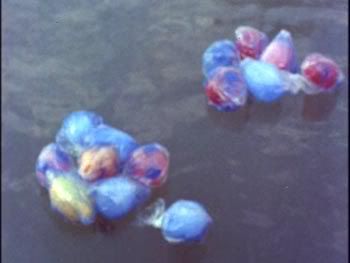


I want to be fair, though. Yes, even in 1965 the ‘special’ effects here must have been considered laughable. However, it’s quite possible that many drive-in theater patrons were completely awestruck by what was, for the time, some incredible carnage. Something like fifteen people must go in the drink here and suffer their horrible demise, and chances are that even veteran trash movie fans of that era had never seen slaughter on such a scale before.
Say what you will, but within his sizable limitations, Grefé was really delivering the goods here. Indeed, the scene is so violent for an American film of this vintage—at least in concept, if not in execution—that it’s quite possible that better effects and more able direction would have forced them to cut the scene down somewhat.* Even granting all that, though, the inability of the swimmers to elude the patently immobile ‘jellyfish’ still inspires more than a few chuckles. Here’s an idea, gang: Swim for shore.
[*All this changed but a couple of years later, when stuff like George Romero’s far more gruesome Night of the Living Dead started playing theaters.]Now, as I’ve noted, this scene is a lot more exciting in the abstract than in the shoddy, flaky concrete. Even so, hopefully Grefé learned something from this as his career continued. The main problem is that this is clearly the film’s ‘big scene,’ but that it takes place with more than half the movie left to run. Unsurprisingly, this is counterproductive to maintaining audience interest. Especially since the rest of the movie, sadly, proves to be the second half of Sting of Death.
Although Grefé wasn’t exactly a novice, having previously directed two films, he was still early in his career. Moreover, unlike his previous films, he was merely hired to direct this one by producer Joseph Fink. As such, he didn’t write the movie’s script, as he tended to do with his other pictures.
Given this, you can’t really blame Grefé for the film’s structural deficiencies, which are severe. One thing I’ve learn over the years is that the first third or half of a film generally ends up inspiring the majority of my review of it. This is because of all the set-up involved; establishing setting, plot, characters and their motivations, etc. Once you get past all that, you start getting more action-y sorts of scenes as the film advances (or in the case of most movies featured here, staggers) towards its climax. Unsurprisingly, scenes like that don’t merit as much commentary as the stage-setting stuff.
Sting of Death is way beyond normal in this regard. As silly as the first half of the film is, the viewer is at least kept marginally involved in meeting everyone, watching the dance numbers—highlighted, of course, by Sedaka’s contribution to the picture—and watching the movie’s most outré sequence.
Sadly, the rest of the film largely consists of various set pieces that, yes, just mark time until the film’s conclusion.Since he worked off of someone else’s script here, these problems can’t be laid at Grefé’s feet. (On the other hand, he didn’t exactly salvage things with his vivid directorial élan, either.)
However, he did write his next excursion into horror, 1967’s Death Curse of Tartu. And that film is throughout about as dull and meandering as the second half of this one. It’s like Grefé was developing a process called ‘Bore-o-Rama’ during Sting of Death, and had perfected it by the time of Tartu.
In any case, let the slog begin. We cut back to the Richardson abode. My mouth actually dropped when I observed that Richardson had in fact kept the ailing Louise behind (!!!). I don’t think they made a secret of this, but it could be that this picture has not always commanded my full attention.
Louise’s continued presence is presumably because, as marine biologist Richardson earlier opined, she wasn’t quite as badly mauled or as severely poisoned as the Monster’s other victim. I mean, you can’t send everyone to the hospital. Meanwhile, he gives her a hypodermic sedative to stop her incessant screaming. “She’s more frightened than anything else,” he lamely asserts. I guess that explains the horribly vivid ‘fear welts’ all over her face.
Then, making sure the girls are safely distracted, he hands John a revolver. Richardson and John continue to treat the girls like they’re absolutely incapable of taking action on their own. This is especially irksome in that they are themselves, to be frank, massive clods. Richardson then leaves to work on the damaged radio, and John moves closer to the camera so the camera shot can focus on the gun. This makes sense, at least in terms of this movie, because the gun never once comes into play at any point in the rest of the proceedings.
Then we cut to a montage of all the kids’ dead bodies floating around. Because the attack scene itself wasn’t all that that well executed, this dwelling on the numerous corpses is actually more affecting. This is true despite that fact that the shots are accompanied by ineptly ponderous funereal music. Dwelling on the death toll in silence would have easily given the scene a much bigger kick.
Here we get our big reveal in which we learn that—SPOILER ALERT!!!—Egon is our monster. Boy, there’s a shock. They sure skillfully diverted our attention from that possibility. He enters what appears to be a small *cough* cave featuring one of your standard Ten Dollar Super Science Control Panels—radio dials to twist, lighted section that blinks, an arc generator—and activates it.
He then walks over to a nearby fish tank. Here he apparently removes from his head a huge jellyfish that he had been wearing like a hat (or a helmet, more accurately). I think. Luckily we’ll see this process in much greater detail later, which will leave me…actually, entirely more confused about what the hell is supposed to be going on here.
Cut to Richardson and guests having dinner, with everyone having changed into nice clothes for the event. Yeah, boy, a dinner scene. That’s the way to ratchet up the tension. And if it was meant to offer the audience a respite from the high tension that already existed, well, it would have been nice if they had provided any.
They yak a bit, although mostly just to run over stuff that’s already happened. Richardson mentions that he’s planning to go fetch Egon the next day. Oh, and since he’ll be out and about, he’ll also bring the scuba gear and do some diving. Jessica asks if she go with. “Karen’s told me how beautiful the reefs are,” she explains.
Thus do we enter this extremely weird part of the movie where everyone acts like they have no idea that there’s a murderous monster running around. I mean, Louise was attacked in Richardson’s swimming pool, with a crowd surrounding it. Even so, Jessica decides heading out into the wild is a grand idea. Indeed, Donna asks to join them too. Richardson agrees, and then sends the girls to bed. Because, you know, they’re all like 12 years old, right?
Having gotten past My Dinner with Richardson, we now pause for a romantic interlude between our young leads. This is set against a window they are spraying with a hose, which is meant to indicate that it’s raining. “It fits our mood,” John glums. However, Eros will not be denied. “Is it possible to fall in love with all this happening?” Karen ponders. I wouldn’t dream of blowing the shock answer for you, but it’s yes.
By the way, Grefé apparently told the actors to whisper their lines here, presumably in an attempt to communicate intimacy. I see what he was going for, but the sound is so bad that you can barely make out what they’re saying. Which, OK, isn’t really impacting our enjoyment or interest level any. So there’s that. Anyhoo, they kiss and…scene.
Apparently Grefé worried we’d be reeling from the action-packed dinner and young lovers scenes. And so we know cut to Richardson, John, Donna and Jessica embarking the next morning on an air boat. That’s right, both men are leaving three of the girls alone, one of which is the ailing Louise, and leaving them behind where the original attack occurred. This should not be taken as of a sign of their trust in Karen and Susan, however. (For instance, they don’t leave a gun behind.) No, it’s because Richardson and John are both morons.
However, who can ponder such things in light of the raw excitement promised by the air boat? I wish particularly to mention Donna, who prepared for the expedition by sensibly wearing a white, mid-thigh white dress. They head out, and there now follows over a minute straight of them plying their air boat through the swamps. This scene is made even more pulse-pounding by the musical accompaniment, apparently taken from an album entitled, “Music to Sleep By.” I’m just sorry you can’t see it for yourself.
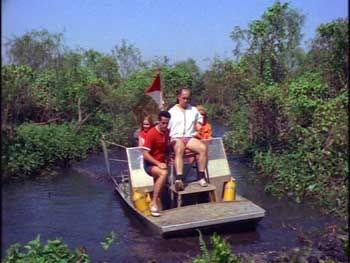
Stare at this image for a minute straight to simulate the awesome excitement of Sting of Death.
Arriving near the dilapidated shack Egon calls home, they disembark, walk around a bit, and then enter it. It really is a ramshackle hovel. The furnishings, such as they are, are all Early American Hillbilly Garage Sale. The most impressive artifacts on display, and by quite some bit, are a fish tank and a kerosene lamp. “Amazing!” Donna avers upon seeing this splendor. “All of this, out in the middle of the Everglades!” Yeah, like stumbling on the Lost City of El Dorado, isn’t it?
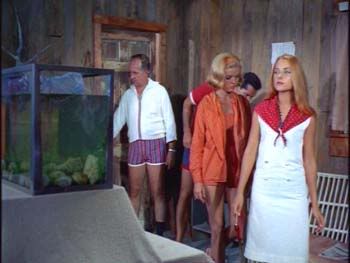
”We’ve done it! We’ve found Blofeld’s secret volcano base!”
When Jessica rather more realistically dubs it “creepy,” John again nobly comes to his associate’s defense. “Well,” he shrugs, “[Egon] likes it well enough.” Sure, why wouldn’t he? He’s got rough skin on half his face! He’s lucky to live in anything better than a refrigerator box. Meanwhile, John nonchalantly picks up and glances through what are apparently Egon’s notes regarding his private research. Hey, a guy like that should be proud that a hunky dude like John evinces even that much interest in his work!
Donna, who is apparently our designated Cute Dumb Chick, looks at some inflated plastic bags, er, jellyfish in the aforementioned home aquarium. Richardson answers that they’re “phacelia,” because he’s a man and a scientist and should never skip an opportunity to condescend to a girl. I mean, why bother to educate yourself if you’re just going to use words like ‘jellyfish.’
Jessica, being a diver, is rather more on the ball, however. Calling Donna “silly,’ she accurately identifies them as Portuguese Men o’ War. “Some people call them jellyfish,” she continues. Sure, the rabble, maybe. Anyway, Jessica’s almost smug enough to be a marine biologist herself. Too bad she’s a girl!
Richardson wanders off to find Egon, and suddenly the movie gets entirely stupider. Yes, really. “I left my cigarettes in the boat,” Donna says. “Be right back!” Neither Jessica nor John even say anything as she leaves. This is less than one day since the Monster attacked them about 20 people congregated in the Richardon’s backyard and nearly killed two of them. Of course, the remaining characters don’t know about the ill-fated boat trip that later killed everyone else. Even so, you’d think someone would say, “Gee, I’m not sure that’s such a great idea,” or at least, “OK, I’ll go with you.”
Now we get a long sequence were Donna wanders around without, predictably, a thought in her head, and is stalked by the Jellyfish Monster. This goes on for a good long while. She pauses to pick up a plant frond (I assume the script called for her to pick up some flowers, but they couldn’t find any in evidence). She literally twirls around as she looks up at a stock footage bird flying overhead—the things you see in the wilderness! And so on.
During this the Jellyfish Monster is often trailing about ten feet behind her and completely out in the open, but she never notices. Perhaps this is why they spent so much time established Egon’s ninja-like ability to sneak up on people.
And so they eat up another whole minute of ‘running’ time before she reaches the boat. Eventually, the Jellyfish Monster gets so close to her—about three feet away and standing almost directly in front of her—that even Donna notices him. She screams, and—yes—stumbles away from her tormentor. She backs into brackish water through which she will scream and stumble away for another good long while before he finally kacks her.
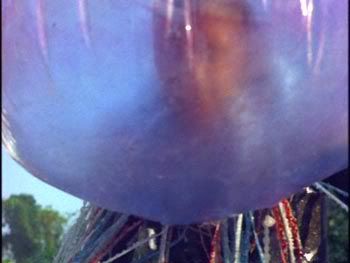
Yeah, you might want to stick with those shots of just his flippers.
We cut briefly away from this awesome jellyfish and mouse sequences as Donna screams for the first time. We return to Jessica and John sitting in Egon’s, er, living room and flipping through some magazines. Jessica looks up for about half a second, but returns her attention to the magazine even before she finishes saying, “What was that?” John isn’t even that responsive. Indeed, he doesn’t even acknowledge that Jessica, sitting right next to him, has said anything. I mean, if these people don’t care that they’re in a horror movie, why should I?
Back to Donna for the pursuit and eventual kacking, all seen from a Monster POV perspective. This goes on for a while, and by the time of Donna’s demise (which predictably occurs off-camera), we’ve ticked off another three minutes of screentime. This might not sound like much, but count to 180 while imagining absolutely nothing of interest and you’ll likely discover that it seems like a very long time indeed.
Richardson reenters the room (well, actually, he reenters shot—he never really left), and suddenly Donna’s screams are heard a lot more clearly. This is sort of weird, given that she was much further away from the shack in the end than she was when she started screaming. “What was that?” Donna repeats. Once more proving his awesome Hero credentials, John answers, “What was what?”
“It sounds like a scream,” a mystified Jessica replies. “Where’s Donna?” Richardson asks, because as a Scientist! he’s a trained observer and able to put all these bewildering pieces together. “Oh, my god!” John says, jumping up. Quick on the uptake, isn’t he? They run right outside the shack, stop there and call for her, but to no avail. Probably because, you know, she’s dead and all.
This intensive search technique is utilized for a good, oh, four seconds before they abandon it. “Let’s get the air boat,” Richardson commands. “We’ll use it to check the lake area!” So they run back to the boat for more AWESOME AIR BOAT ACTION! Woo-wheee! Luckily, the Everglades are really small and they spot Donna’s bandana in a minute or two.
Actually, watching the scene more carefully—the things I do for you people—nobody mentions the bandana. However, Jessica points as the boat cruises through and shouts, “Look, bubbles!” Richardson agrees. “She must be right below!” he concurs. Yes, this is the only possible explanation for bubbles appearing on the surface of marsh water.
And so they don their scuba tanks to conduct a search. Oh, boy, if there’s one thing even more intrinsically fascinating to watch than folks tooling around in an air boat for minutes on end, it’s people scuba diving for minutes on end! Sea Hunt, you are avenged!
They jump into the murky waters, which again are utterly clear below, and, well, scuba around. Eventually, though, Jessica gets distracted by some pretty fish—THIS REALLY HAPPENS—and swims off on her own. The Jellyfish Monster appears and gets her. Some time after this, the guys—who, I would remind you, are down here searching for another girl they let wander off to her doom—finally notice that, hey, where’s Jessica?
Oh, and they run out of air, because apparently scuba tanks only allow for like three minutes of diving time. (Not that I’m complaining about that!) John, being manly, then heads back down to “free dive”, which is what we layman call swimming around without a scuba tank.
Back to the house. Karen is all het up because the others aren’t back yet. Susan, for her part, is basically played as a block of wood. She decides to take a shower. Because, you know, who’d want to stay together in a situation like this? Not to mention that they’re in another part of the house completely from the ailing Louise. But hey, she’s not the boss of them.
Well, those guilty of the sin of personal hygiene must be punished, of course, so that’s the end for Susan. This is confirmed a) she *gasps* strips for the shower, because even though the camera stays on her face during this, we’re shockingly aware that she’s, like, naked, and besides, we do see her in her slip, and b) there are a few shots where we’re briefly allowed to semi-see her butt through the marbled glass shower door. So, you know, she’s kind of a whore.
The justice of her demise established, we get some stalking flipper shots coming down the hallway, and then she’s attacked in the shower. (By the way, the water clearly isn’t really on, she just mimes being under it.) This is presumably meant to evoke Psycho, made just five years earlier. However, the scene is saved to some extent by being entirely too ineptly filmed to really ape Hitchcock very much. To be fair, though, Grefé was filming in a real bathroom, so there’s only so many places he could put the camera.
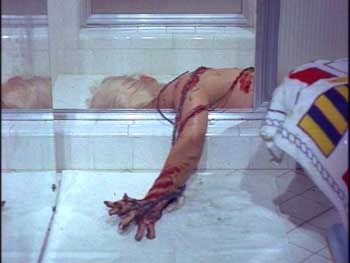
”OK, I think I found what was clogging your drain.”
Still, this is one of the more graphic kills, as Susan is actually attacked on camera and gets some barbecue sauce venom slathered on her face and neck as the Monster strangles hand. Exit Susan. She screams quite a lot before she goes, but naturally Karen doesn’t hear this.
Three thoughts jumble together in quick response to this. First, man, this universe has the worst acoustics. Second, how big is this house that Karen can’t hear her friend screaming like that? Third, since the shower is right down the hall from the room Louise in, that means that if Louise had started shrieking for help or in pain or something, they wouldn’t have heard her either. It’s good to have friends watching over you.
Karen is recumbent on the cough downstairs, and *gasp* she’s approached by a looming shadow of a figure menacingly holding his arms over its head. However, it turns out to be the returning John. (!!) Maybe he was drying his armpits. Chagrined, he and Richardson tell Karen they lost Jessica and Donna.
“Right now we’re going to get Susan and Louise and take them to the mainland,” Richardson decides. That’s right, this is something they could have done yesterday. “It’s not safe on the island,” John declares. Boy, nothing gets past that guy. Gee, good thing that gaggle of silly girls had these men to make the decisions for them. Can you imagine where they’d be otherwise?
So they head upstairs, and Louise is clearly worse (despite the awesome care and attention she’s been receiving), and then they find Susan’s body. Karen screams, while John struggles to convey an emotion, any emotion, on his impassive face. Karen continues to scream and runs down the stairs. “Catch her!” her dad yells. “She’s hysterical!” Yes, Karen, stop overreacting. Gah!
She runs outside, straight into the arms of…Egon. Regular Egon, though, not Monster Egon. (The timing of this is technically impossible, by the way, since he apparently needs the equipment in his cave to change back and forth. But eh, whatever.) Egon indulges in the opportunity to hold Karen and comfort her.
Richardson fills Egon in, and notes that they’re leaving for the mainland straight away. Egon demurs, pointing out that Richardson’s motorboat—which again, has apparently been sitting there the entire time—is now wrecked. “When did that happen?!” Richardson barks in comical exasperation, sounding exactly like old Mr. Wilson being confronted with Dennis the Menace’s latest piece of mischief.
And, oh, neither air boat has much gas left. “Gene forgot to bring the new supply,” we’re told. Man, Richardson runs a real shipshape operation here.* Conveniently, though, Richardson has nearly fixed the radio. Remember? Back at the beginning of the movie, when we watched the Monster touch a screwdriver to some wires? I can only assume this represented ‘wrecking the radio.’
[*Uhm, isn’t the uncle’s house right across the canal? Doesn’t that have a radio? Some gas to scavenge? Maybe another boat?]Ricardson and John go to the communications hut, where the former tells John to leave the outside door open. Why? You’ll see. Meanwhile, Egon is inside the house still comforting Karen. She’s so distraught that she doesn’t notice his clumsy semi-gropings, or the way that he’s draped all over her. That you’d think she’d notice, but, you know, the distraught.
Egon leaves to check on John and Richardson. He lurks outside the communication shack and observes their progress on the radio. So there, that’s why Richardson had the door left open, so Egon could listen in on them. But then, as Egon leaves, he silently closes the door as he goes. Why? You’ll see.
Egon returns to Karen. He decides the time is right and spills the beans. He explains that he killed all of Karen’s friends because “they were no good.” And now the two of them could go live in his cave together forever and ever. To his chagrin, though, Karen isn’t entirely on board with all this. Women. They say they want you to be spontaneous, but then they get all in your face when you are. Also, when they tell you don’t need to get them a Valentine’s Day gift, because she agrees it’s a phony holiday, brother, you better get her a Valentine’s Day gift!
As such things happen, as soon as Karen learns all this she faints. I’ve read several of the standard Victorian era medical texts, and apparently this is because females are particularly susceptible to what doctors call ‘brain fever.’ Anyway, this allows Egon to carry her off to his air boat and make his escape.
Indeed, he might have snuck away completely unnoticed, if not for one thing: In the communications shack, Richardson suddenly shouts, “John, the door’s closed!” This alerts them…to something, I guess. Anyway, the door is indeed just closed. It wasn’t jammed shut to trap them in there or anything. Apparently Egon just closed it so that Richardson could eventually notice it was closed and be alerted that mischief was afoot. Which I guess is also why Richardson wanted the door left open in the first place. And so the great mysteries of The Door that Didn’t Bark in the Nighttime is solved.
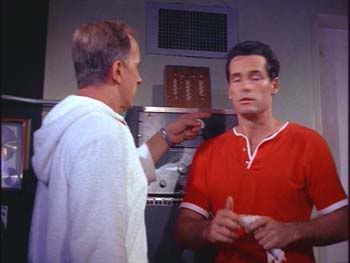
”John! Good lord, look! THE DOOR IS CLOSED!!!”
Meanwhile, a closed door can only mean one thing. “I’m going to check on Karen!” John yells. They rush outside just in time to (I guess, you kind of have to put the pieces together here) see Egon leave. And so they jump into their own air boat and…that’s right, we now get an air boat chase. And yes, it’s fully as exhilarating as I’m sure you’re imagining it to be.
And so this progresses for over three straight minutes before Egon arrives above his underwater cave. Lucky you; to you the chase lasted as long it took to read a single sentence; to me, a lifetime! Anyoo, the guys have fallen a bit behind. This allows Egon the time to shove Karen into the water and drag her down through the cave’s underwater entrance.
Man, I’m bored. OK, here’s scoop. Egon shows us how he transforms into the Jellyfish Monster, a process portrayed at some length, and I can’t figure out what’s going on. He doesn’t don the overlarge jellyfish he has in his tank, he stands over it, and custard appears on his face, and I guess he basically excretes a new jellyfish on top of his head, and at the same time literally manifests his wetsuit and flippers, and his head is encased in a semi-transparent inflated garbage bag, and there you go, rah, he’s a monsta.
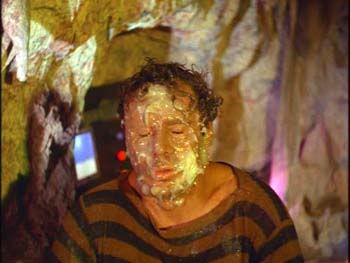
The kids went too far when they gave Egon an exploding custard donut.
So John dives down and finds the cave, and he has a flare, and he and Jellyfish Monster circle around each other warily for several hours, and occasionally the Monster grabs him but in perhaps the single most retarded example of the Hero’s Death Battle Exemption ever, the Monster conveniently suddenly doesn’t have any venom on his hands, so John’s OK, and they stumble around the little set for a good long time, and then John accidentally drops his flare into the jellyfish tank, and this mortally wounds both the Master Jellyfish and Egon himself, and smoke comes out of the Ten Dollar Super Science Control Panel, which heralds the traditional Inexplicable Climatic Explosion, which is realized by uncapping a scuba tank so that we see a burst of air bubbles in the water.
And that’s basically it. Of course, there are a few fine points during this final twelve minutes. The best is Egon’s inevitable Mad Scientist Rant. Again, though, because of the sound you can barely hear parts of it:
“I told your father I could do it, but he wouldn’t believe me. They all said I was crazy!* But I did it. I stole the instruments from your father. Then I fed the electricity down here from my house on the island. Look at him. Look at him, Karen! Better than 20 inches across! Living in captivity! All the bright marine biologists said they couldn’t be grown! But I found the answer. Sea water, electricity, and human blood [!!!!], mixed with a chemical I stole from your father’s lab.”
[*Close, Egon, but the proper formulation is, “They called me mad! Mad, am I? I’ll show them! I’ll show them all!”]In the end, Egon lays dying (in perhaps the film’s only effective effect, he has what are supposed to be bloody, exploded man/jellyfish remains around his head. Karen is genuinely upset, which is kind of weird, because although she kept saying she liked Egon when he pestered her about it, this is the first time I got that she really was supposed to care for him.
Karen keeps yelling for John to get Egon out of the cave too. However, Egon knows it’s too late, and frankly John doesn’t really look like he cares in any case. (Have I mentioned that I really don’t like John very much?) So he hauls Karen out of there. Why can’t she swim up on her own—it’s not like John even has a scuba tank—and have John take Egon? Because, I guess, she’s a girl. So we get the bubble fountain, and that ends that.
Ta da.
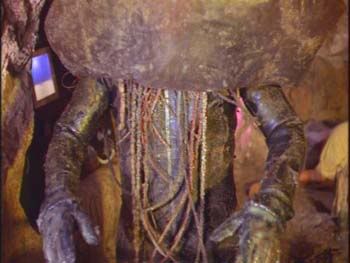
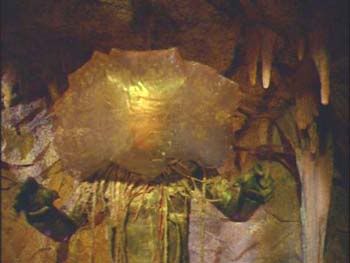
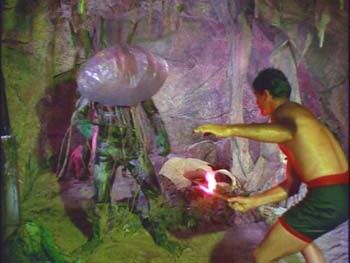
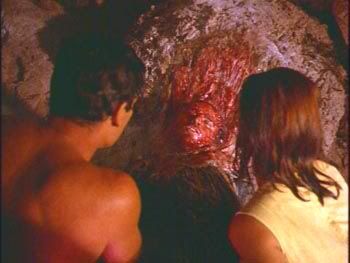
The Words of the Master:
Sting of Death is available on one of those incredibly loaded DVDs Something Weird once flooded the market with. For one low price you get not only Sting of Death, but Death Curse of Tartu. Plus you get a bad nudie short, and what appears to be a hilarious ‘man trapped on an island of cannibal women” movie that they cut down to 30 minutes, meaning that it’s all the good stuff. Then there’s a selection of trailers for several of Grefé’s movies. That right there is a terrific package.
What really makes the disc invaluable, though, is that Grefé contributes commentary tracks for both movies. Moreover, these are moderated (a format I always though worked best, since it keeps things focused, and reduces the likelihood of the dreaded “I forgot I’m supposed to be saying anything” five minute commentary pause) by none other than Frank Henenlotter, the director himself of such cult films as Basket Case and Frankenhooker. (Oddly, Henenlotter sounds a lot like Alan Alda.)
They prove a great duo. Luckily, Grefé has a great memory and is able to relate a lot of details about making the films. Moreover, he has a sense of fun about the movies, which helps a lot. I’m sure this was a great time of his life, being a guy in his early ‘30s, making movies more or less in his backyard and with a lot of pretty girls around all the time. Not a bad life, really. And hey, here he is talking about his pictures decades later, because people are still watching them.
Right off the bat, Grefé explains (or confirms, really) that was hard to keep the Monster’s garbage bag head inflated. This explains why the Monster, except in key scenes, was generally shot from the knees down: It meant they didn’t have to have the guy playing the monster wear the full rig.
Grefé gives fully of some great details. He relates the travails of filming in the producer’s house (the guy insisted, to save money), and of course how they trashed the place. And the blood blister on Richardson’s head was written in with the guy smacked his head after falling off one of the air boats. It’s a real education in what it’s like to make a low-budget film. Indeed, even with the changes in technology and such, I imagine a lot of people working on similar productions today would nod along to a lot of what he says.
They also get into some of Grefé’s marginally more famous work, like the Willard-with-snakes picture Stanley. Grefé tells an amusing story about working with the great character actor Alex Rocco on the film (Rocco played Moe Green in The Godfather, who gets memorably shoot through the eye). Rocco was to be attacked by snakes in a pool, but refused to swim around with real reptiles.
Grefé agreed to use rubber snakes in the scene and fix it in editing, but had some guys ready to throw real snakes at Rocco once he was in the water. Rocco apparently exited the scene swearing quite heavily at the director. Henenlotter replies that he heard Rocco himself relating this story during a Bob Costas interview, and that the actor still sounded pissed.
Sadly, there’s not much of a story behind the Neil Sedaka song. He was in Florida hitting the club circuit, they offered him a couple of grand to sing a song for the movie, and he did.
As I said, it’s a perfect combo. Henenlotter obviously prepared for this gig, and genuinely sounds like a fan of Grefé’s work. He did some research and knows what questions he wants to ask, but isn’t so overprepared that he can’t enjoy the movie as it unspools. Indeed, he points out several of the same things my review does. Even so, there’s never an air of disrespect here. Both men are toilers in the low budget fields, and Henenlotter can enjoy the film’s deficiencies without once ever sounding snide about them. Like us, he thinks these add to the movie’s enjoyment value, and Grefé seems to appreciate this.
Grefé, for his part, again has a great memory for people, and generally has an anecdote for anybody Henenlotter mentions. Moreover, he’s capable of enjoying the film for what it is, too, and takes Henenlotter’s utterly affectionate critiques in stride. Both men know the compromises inherent in making films under these conditions, and Grefé just sounds tickled to know that people are still entertained by his films. It’s a terrific commentary.
Click on the banner below to see the Roundtable Supersoaker!
